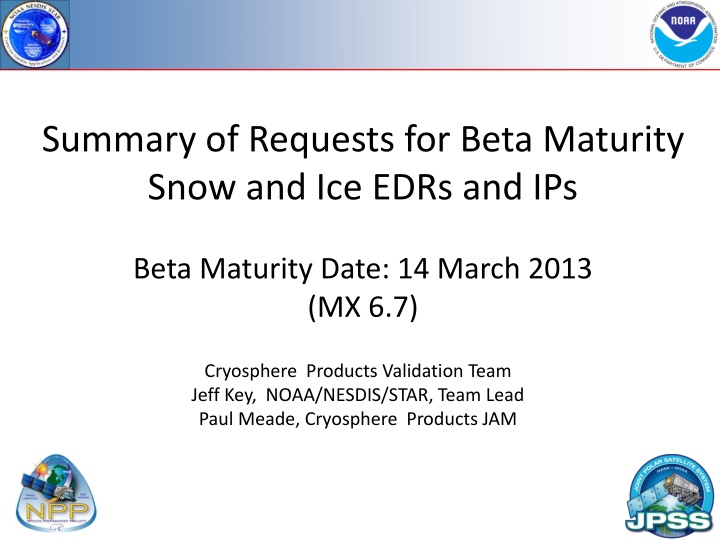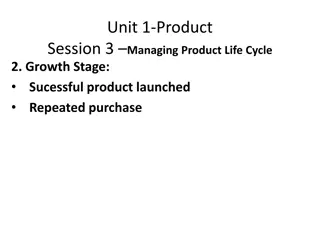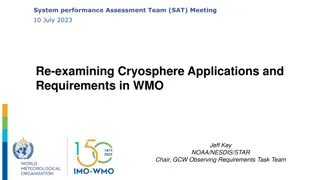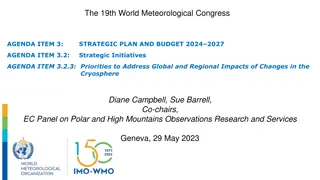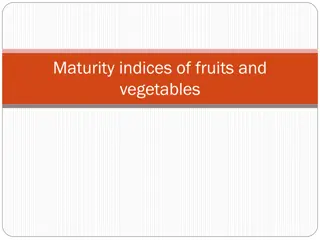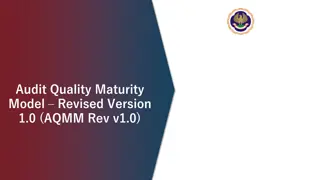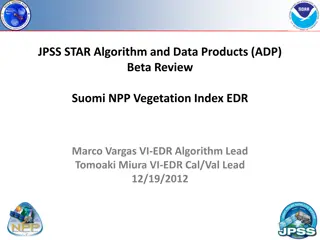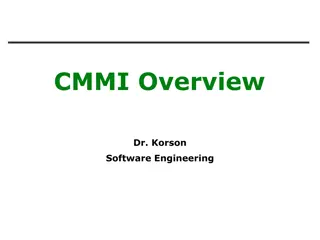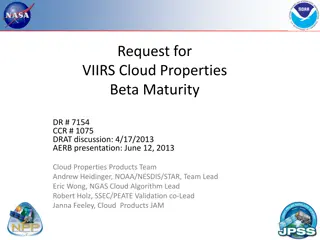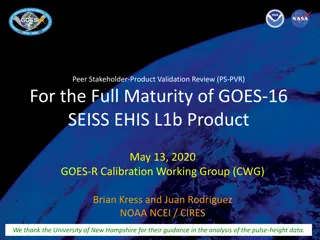Cryosphere Product Beta Maturity Summary and Comparison
Requests for beta maturity of snow and ice EDRs and IPs were addressed on 14 March 2013 by the Cryosphere Products Validation Team. Criteria for beta justification and validation were outlined for various users in the U.S., including NOAA and NASA. Specific focus was on the VIIRS Ice Surface Temperature EDR, with a comparison to the IceBridge Flight IST measurements.
Download Presentation

Please find below an Image/Link to download the presentation.
The content on the website is provided AS IS for your information and personal use only. It may not be sold, licensed, or shared on other websites without obtaining consent from the author.If you encounter any issues during the download, it is possible that the publisher has removed the file from their server.
You are allowed to download the files provided on this website for personal or commercial use, subject to the condition that they are used lawfully. All files are the property of their respective owners.
The content on the website is provided AS IS for your information and personal use only. It may not be sold, licensed, or shared on other websites without obtaining consent from the author.
E N D
Presentation Transcript
Summary of Requests for Beta Maturity Snow and Ice EDRs and IPs Beta Maturity Date: 14 March 2013 (MX 6.7) Cryosphere Products Validation Team Jeff Key, NOAA/NESDIS/STAR, Team Lead Paul Meade, Cryosphere Products JAM
Cryosphere Product Users U.S. Users NIC, National/Naval Ice Center NOHRSC - National Operational Hydrological Remote Sensing Center NWS, National Weather Service, including the Alaska Ice Desk OSPO, Office of Satellite and Product Operations CLASS, Comprehensive Large Array-data Stewardship System NSIDC, National Snow Ice Data Center STAR, Center for Satellite Applications and Research GSFC, NASA/Goddard Space Flight Center Hydrological Sciences Branch User Community Navigation, Transportation Agriculture and Hydrology Emergency Management Operational Weather Prediction Climate Research DOD 2
Beta Justification Summary (All Products) Criteria: Early release product EDR performance is dependent on VIIRS SDR, VIIRS Cloud Mask IP, Ice Concentration IP, Aerosol Optical Thickness IP. SIC is also dependent on NCEP ancillary surface data, LUTs for model TOA snow/ice reflectance, broadband albedo, atmospheric transmittance and a modeled climatology based snow depth/ice thickness LUT. SDRs and VCM are provisional; AOT is beta. Criteria: Minimally validated Evaluation is based on a limited number of focus days (global comparisons for retrieval products), with some detailed analysis on other days. Criteria: Available to allow users to gain familiarity with data formats and parameters Users can access and read the products and the product compares reasonably with the heritage satellite snow map products Criteria: Product is not appropriate as the basis for quantitative scientific publication studies and applications The product has known flaws, but these products are of sufficient quality to justify use by a broader community 3
VIIRS Ice Surface Temperature (IST) EDR IST is the radiating, or "skin", temperature at the ice surface. It includes the aggregate temperature of objects comprising the ice surface, including snow and melt water on the ice. Inland water bodies, coastal ice, and land ice temperatures will be obtained from the LST EDR. 4 4
Comparison VIIRS IST EDR with IceBridge Flight IST A comparison of IST measured by the NASA P-3 aircraft's KT-19 instrument (J. Yungel, PI) and the VIIRS IST EDR mean VIIRS = -33.2358 C mean KT-19 mean MODIS = -33.3882 C = -33.7450 C VIIRS - KT-19 = +0.5092 C MODIS- KT-19 = +0.3568 C VIIRS MODIS = +0.1524 C Comparison between the IST (in deg C) measured by the KT-19 (in black, smoothed over 100 points), the nearest VIIRS IST measurement (in green) and MODIS observation (red). The comparison is for the leg from 16:03:37 -19:10:08 (west of -120 lon). The VIIRS overpass occurred from 16:01 - 16:06 UTC . VIIRS, MODIS, and the KT-19 IST's show consistent good agreement along the flight track, with VIIRS close to meeting the 0.5 C (or K) spec. 5
IST Issues and Plans Issues VIIRS IST EDR over false ice retrieved by the Sea Ice Concentration IP. Current IST bias should be reduced with updated IST regression coefficients Plans No code changes currently planned Update of IST regression coefficients based on matchup with VIIRS and truth IST sources Ability to check for reduced quality VIIRS Ice Concentration IP input based on quality flags to with additional quality checks to be added to the Ice Concentration IP 6
Conclusions: IST EDR VIIRS IST EDR has met the beta maturity stage based on the definitions and the evidence shown It exceeds the definition of beta in most cases Off-line EDR product performance overall is close to meeting requirements at this time and meets requirements in some cases. It continue to improve. Some issues have been uncovered during validation and solutions are being evaluated. Improvements in IST EDR performance may be realized as the VIIRS Cloud Mask IP matures and additional quality flags become available in the VIIRS Ice Concentration IP to avoid IST retrievals near clouds 7
VIIRS Sea Ice Concentration IP Sea ice age is defined as the time that has passed since the formation of the surface layer of an ice-covered region of the ocean. The sea ice characterization EDR provides an ice age class. Sea ice concentration, which is the fraction of a horizontal cell covered by ice, is an intermediate product (IP). 8 8
Comparison of VIIRS Ice Concentration to Passive Microwave VIIRS sea ice concentration IP is retrieving false sea ice over lower-latitude ocean areas. 9
Ice Concentration Issues and Plans Issues False ice frequently observed near cloud edges. Significant discontinuities in ice concentration evident at 85 deg SZA transition between day/night for VCM and Ice Concentration to thermal based retrievals. Ice Concentration biases Minor discontinuities related to ice tie points evident in the ice concentration Plans We are working to get changes into the IDPS DR 7139, 4959, 4987, 4129, 7139 Further qualitative and quantitative comparisons with independent ice concentration sources Implementation of additional quality checks and associated quality flags (MX 9.0) 10
Conclusions: Ice Concentration IP VIIRS Sea Ice Concentration IP has met the beta maturity stage based on the definitions and the evidence shown It exceeds the definition of beta in most cases Off-line IP product performance appears to be of sufficient quality for use by the Sea Ice Age EDR to identify ice to be classified as well as for Ice Surface Temperature EDR to identify sea ice for retrievals Some issues have been uncovered during validation and solutions are being evaluated. 11
VIIRS Sea Ice Characterization EDR Sea ice age is defined as the time that has passed since the formation of the surface layer of an ice-covered region of the ocean. The sea ice characterization EDR provides an ice age class. Sea ice concentration, which is the fraction of a horizontal cell covered by ice, is an intermediate product (IP). 12 12
VIIRS Sea Ice Characterization EDR vs. Passive Microwave Sea ice extent is realistic, but with some false ice over open water, misclassification of new/young vs. other ice, and some misplacement of land values. 13
Sea Ice Characterization Issues In general, significant discontinuities in ice classification between New Young and Other Ice have been observed in the granule level mapped composite data. Ice classification discontinuities are most evident near the terminator region where the algorithm transitions from the day reflectance based algorithm to the night energy balance based algorithm The snow depth thresholds based on the snow/depth ice thickness climatology LUT are problematic False ice is frequently observed near cloud edges Ice misclassifications occur due to low opacity clouds or ice fog, particularly during nighttime Lower reflectance of melting sea ice appears to cause the SIC EDR to indicate New/Young Ice, although this type of ice cannot be present this time of year. 14
Ice Concentration Plans Implement additional quality checks for extended cloud adjacency and partly cloudy conditions within the ice tie point search window in the Sea Ice Concentration IP Analysis of sensitivity of retrievals to NCEP ancillary data inputs and snow depth on sea ice Revision, testing and implementation of SIC EDR Nighttime Algorithm, possibly utilizing a local sliding IST window. Replace the algorithm? Revision, testing and implementation of SIC EDR Daytime Algorithm to possibly include: Definition and utilization of melt season period where New/Young ice cannot exist, or utilize IST checks to assist with ice type definition (Oct. 2013) Use of ancillary precip. field to improve snow depth estimates and to derive ice age based on ice thickness computed from snow depth (Oct. 2013) Mapping of fresh-water ice 15
Conclusions: Ice Characterization EDR VIIRS Sea Ice Characterization EDR has met the beta maturity stage based on the definitions and the evidence shown It exceeds the definition of beta in most cases Off-line product performance appears to be of sufficient quality for Beta maturity Issues, some major, have been uncovered during validation and solutions are being evaluated. 16
VIIRS Snow Cover EDR The snow cover product contains two products: a fractional snow cover (FSC) and a binary snow cover (BSC) mask. The fractional snow cover is defined as the fraction of a given area of the earth s horizontal surface that is masked by snow. The binary snow/no- snow mask provides a mapping of snow covered areas as either containing or not having snow. Snow Cover is defined to be the horizontal extent of snow cover. It does not include snow hidden by vegetation or other obstructions when viewed from above. RGB Image shows dense smoke (high absorption) in northwest, north central and central coastal portions of image. 17 17
VIIRS Binary Snow Map vs In Situ Snow Observations Daily statistics of correspondence between VIIRS snow and in situ data. Location of US Coop Stations Total hits include correct snow-snow and land-land classifications Total errors include VIIRS snow misses and VIIRS false snow identifications Observations from US Cooperative network stations over Continental US have been used. The number of daily VIIRS-in situ match ups ranges from 150 to 1030. 18 Except of one day disagreement between VIIRS daily snow retrievals and in situ data did not exceed 10%. 18
Plans and Issues: Binary Snow Cover Several changes/modifications to the Binary Snow Map algorithm are considered Spatial-based filter to identify potentially spurious snow Climatology-based filter to identify false snow Changes to the algorithm threshold values to improve snow detection In the backscatter Over forested areas Detailed performance characterization requires: Comprehensive evaluation of the product stratified by the season of the year, climatic/geographic zone and surface cover type A more detailed analysis of the algorithm and product performance at local scales Further validation of the VIIRS Binary Snow Map product with the most recent cloud mask is needed before the decision on the provisional maturity of the product can be made 19
Conclusions: Binary Snow Cover The VIIRS Binary Snow Cover Product (which is part of the VIIRS Snow Cover EDR) has met the beta maturity stage based on the definitions and the evidence shown It exceeds the definition of beta in most cases The product performance is close to meeting requirements at this time. Issues have been uncovered during validation of the VIIRS Binary Snow Cover Product and solutions are being evaluated. Identified problems are mostly related to failures of the VIIRS cloud mask algorithm and product If the accuracy of the cloud mask does not change as the result of latest improvements, modifications to the VIIRS Binary Snow Map algorithm should be introduced to at least partially compensate for the cloud mask errors 20
VIIRS 2x2 Snow Fraction Characteristics VIIRS Snow Fraction product has been minimally validated: globally for each day at 5 km grid cells in months representative for four seasons globally averaged for months at 5 km grid cells locally at pixel resolution for numerous 5 min granules VIIRS Fractional Snow Fraction product is of questionable utility: Snow fraction computed based on a 2x2 aggregation of the binary map is not a valid approach due to an inadequate number of pixels used for aggregation Snow/No Snow classification in the Binary Map is based on a 0.4 NDSI threshold which corresponds to an approximate 50% VIIRS imagery resolution sub-pixel snow fraction. Since a 2x2 aggregation uses only 4 pixels, if just a few of the pixels used in the aggregation have less than 50% snow fraction the fractional snow will be entirely missed Differs significantly from other snow fraction products Does not represent the variability of snow fraction within snow zones The current VIIRS 2x2 aggregated snow fraction provides no additional information beyond that already provided by the Snow Binary Map It is likely that it will not (ever) meet requirements for fractional snow greater than zero and less than 100%. Therefore, the sample set requirements for Accuracy, Precision, Uncertainty (APU) will not be satisfied 21
Snow Fraction: Transition Zones VIIRS fraction Image MODIS fraction Current VIIRS 2x2 snow fraction (top) snow to no snow transition regions are unrealistically narrow compared to the MODIS MOD10 based snow fractions (figures taken from analysis produced by Igor Appel) 22
Conclusions: Snow Fraction Alternative snow fraction approaches are available as candidates to replace the current VIIRS 2x2 aggregated Snow Fraction product: NDSI regression based Snow Fraction Globally produced, MODIS MOD10 snow fraction heritage Potentially easy to implement with low/minimum impact to the current IDPS operational system Multiple End Member Spectral Analysis (MESMA) Originally proposed for NPOESS . Science algorithm tested with pre-launch MODIS proxy data Requires further testing with global VIIRS data Potential latency impact to IDPS unless further optimized Potentially can produce the most realistic and accurate snow fractions 23
